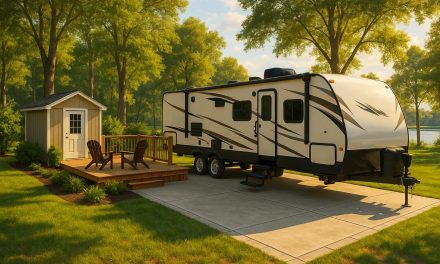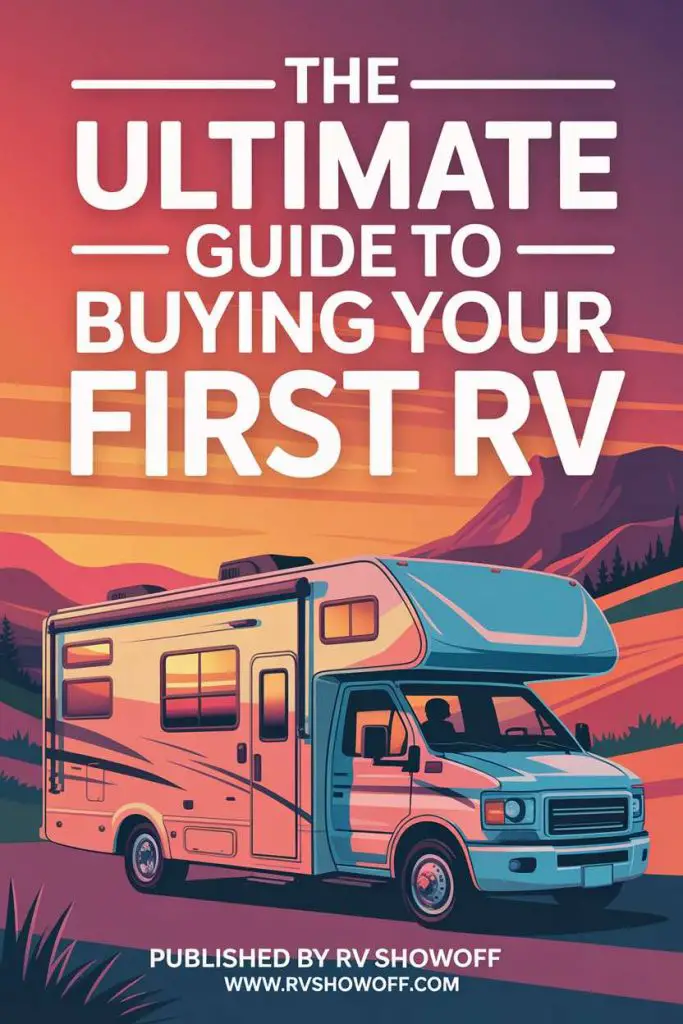Would you like to save this article?
You might be wondering, are RV loans bad, or will financing your camper land you in trouble? RV loans often come with higher interest rates than car and home loans. This guide will help you spot the risks, understand the true costs, and make smarter choices before taking out an RV loan.
Keep reading to learn what no one tells you about RV financing.
The Basics of RV Loans
RV loans help you pay for your camper over time, but the rules can feel different from car or home loans. You might notice unique interest rates and payment plans—so it pays to check the details before signing anything.
How RV loans differ from other types of financing
You pay higher interest rates with an RV loan than you would for a car, truck, or home mortgage. Loans for RVs can last up to 20 years; this is longer than most car loans and almost as long as some mortgages.
Lenders often ask for proof that you have managed large loans before, usually at least half the amount you want now.
Your credit score needs to be stronger too, since lenders see RVs as bigger risks. These are secured loans; the lender can take your RV if you do not pay. Most of your early payments go toward paying off interest instead of the principal amount—this can lead to paying much more over time compared to other types of financing or debt like a regular auto loan or small personal loan.
Typical loan terms and interest rates
RV loans come with some unique terms and rates that can hit your wallet harder than you might expect. Here’s a clear breakdown to help you get a real sense of what you might face if you finance your camper or motorhome:
| Loan Term | Interest Rate (Excellent Credit) | Example Loan Amount | Interest Paid Over Loan Life | Key Points |
|---|---|---|---|---|
| Up to 20 years | 7.00% to 8.5% | $50,000 | $36,000+ (for 15 years at 8%) | Long terms mean lower payments but much more interest paid. |
| 10 years | 7.00% to 8.5% | $50,000 | $22,000+ (for 10 years at 8%) | Shorter terms cut total interest but raise monthly costs. |
| 15 years | 7.00% to 8.5% | $50,000 | $36,000+ (at 8%) | Most lenders use 10-15 years for RVs, not just five or seven like car loans. |
| Any (with lower credit) | Higher than 8.5% or rejected | Any | Can’t qualify, or pay sharply higher interest | Credit scores of 700 or lower mean tougher approval and more cost. |
– RV loan rates stay higher than most car loans.
– Loans can last as long as a home mortgage, sometimes stretching 20 years.
– The longer you stretch out the loan, the more you lose to interest, sometimes as much as $36,000 on a $50,000 loan.
– Excellent credit (800+) gets the best rates, but a score under 700 risks sky-high rates or even denial.
– Even for top-tier borrowers, current rates rarely dip under 7%.
– Shorter terms push monthly payments higher but save thousands in interest.
– You need to weigh the loan term and your credit score carefully, since it has a huge impact on your total cost.
Risks of Financing an RV
Financing an RV comes with big risks. You might face high interest rates, making your payments costly over time.
High interest rates
High interest rates can be a big problem for RV loans. Right now, new campers have interest rates of around 7.00% to 8.5%. If you take out a $50,000 loan at 8% for 15 years, you will pay over $36,000 in interest.
That’s a huge amount!
Your credit score plays an important role in the rate you get. Borrowers with scores of 700 or below may end up with high rates or even face rejection for loans. This adds extra costs and risk to financing your RV.
Take your time and consider these factors before making any decisions about borrowing money for an RV.
Depreciation of RV value
New RVs lose value faster than cars or trucks. For example, a client bought a fifth wheel camper for $90,000. Just two years later, they could only sell it for $58,000. That left them with a loan deficit of $32,000.
Dealers often undervalue trade-ins and inflate new purchase prices. Many buyers choose zero down payments, which can create big financial trouble later on. This makes it hard to resell the RV or trade it in without losing money.
Potential prepayment penalties
Some RV loans might come with prepayment penalties. This means that if you pay off your loan early, you could face extra fees. These fees are not very common, but it is smart to check your loan agreement for any mention of them.
If you’re thinking about paying off the loan ahead of schedule, knowing these fees can save you money in the long run.
Paying off your loan early has its benefits too. It can cut down on total interest costs. For example, a $50,000 loan at 8% interest over 15 years adds up to more than $36,000 in interest if paid as agreed.
So, taking care with early repayment decisions matters a lot!
Impact of poor credit scores on loan approval
A poor credit score can really hurt your chances of getting an RV loan. If your score is 700 or below, you might face high interest rates or even loan rejection. For example, someone with a score in the high 600s received a whopping 22% interest rate.
This means you will pay much more over time.
Lenders look closely at your creditworthiness during the approval process. Your credit history plays a big role in deciding if they will lend to you and how much they will charge in terms and conditions.
Understanding these risks is crucial before applying for financing on an RV. Next up, let’s explore the costs associated with RV loans.
Costs Associated with RV Loans
Financing an RV comes with several costs that you need to know about, like down payments, monthly payments, and fees that can sneak up on you. To learn more about these hidden expenses and how they affect your budget…
keep reading!
Down payments
Down payments for RVs are important. You usually need to pay at least 10% of the purchase price upfront. This means if you buy a camper worth $20,000, you should plan on putting down about $2,000.
Some lenders might ask for even more, up to 20%.
These down payments have changed over time. A few years ago, some buyers could get away with zero down payment. Now it is wise to save up before buying an RV. The bigger your down payment, the less money you’ll owe later on.
Understanding this helps you see how financing works and what costs lie ahead… Next, let’s talk about loan terms and interest rates connected to RV loans.
Monthly payments and hidden fees
Monthly payments and hidden fees are two key aspects of RV loans. Understanding them can help you avoid surprises.
- Monthly payments can be high, especially if you choose a shorter loan term. For example, a $50,000 loan at 8% interest for 15 years leads to over $36,000 in interest alone.
- Many loans come with hidden fees that can add to your overall cost. These fees may include processing fees, late payment charges, or account maintenance costs.
- Add-ons from dealerships often increase your monthly payments. Options like extended warranties or insurance plans may sound appealing but can drive up your total costs.
- Some dealers mark up interest rates for profit margins. This means you’re paying more than necessary for financing.
- Credit unions or online lenders might offer lower rates but check their terms closely. Monthly payments could be higher with these options if the loan term is shorter.
- Always read the fine print before signing any loan agreement. It helps you spot potential hidden fees and understand your total costs better.
- Your financial situation also affects your monthly payments and interest rates. A higher credit score usually leads to better offers on loans.
- When financing an RV, ensure you’re aware of all potential costs upfront to plan your budget effectively.
Add-ons offered by dealerships
Dealerships often suggest add-ons that can raise your costs significantly. These can include extras like extended warranties, insurance, or special financing options. Dealers sometimes mark up the interest rates on loans too.
For example, a camper worth $20,000 might be sold for $30,000 if the purchase price is adjusted with these add-ons.
These added features may sound great but check them closely. They can increase your monthly payments and total loan cost. Understanding what you really need versus what dealers push can save you money in the long run.
Always weigh these options before making a decision about financing your RV.
Dealer Financing vs. Securing Your Own Loan
Dealer financing can be quick and easy, but it may not always give you the best deal. Securing your own loan could save you money in the long run, especially if you shop around for lower rates.
Pros and cons of dealer financing
Dealer financing for RVs can seem easy, but it’s not always the cheapest or smartest route. Here’s a clear look at both the good and the bad of going through an RV dealer for your loan:
| Pros | Cons |
|---|---|
|
|
Benefits of working with credit unions or online lenders
Moving from dealer financing to credit unions or online lenders can be a smart choice. Here are some benefits you might find.
- Credit unions often give the best rates. This can help lower your monthly payments.
- They may offer shorter loan terms. While this means higher payments, you pay off the loan faster.
- Online lenders, like LightStream and Discover Personal Loans, have simple processes. You can apply for a loan at any time.
- These lenders may have fewer fees. That means more money stays in your pocket.
- Working with credit unions often means personalized service. You get help from people who care about your needs.
- Membership is usually required to borrow from a credit union. But once you’re in, you gain access to great rates and products.
- Some credit unions do not finance private or out-of-state purchases. Be sure to ask before applying.
Choosing the right lender is important for your financial health. Consider these benefits as you explore your options.
Does It Make Sense to Finance an RV Right Now?
High interest rates make financing an RV tricky right now. You should think carefully about your finances before making a decision.
Current market trends and high interest rates
Right now, interest rates for RV loans are pretty high. If you have excellent credit, around 800 or more, you might see rates between 7.00% and 8.5%. Those with a lower credit score, say in the high 600s, could face shockingly high rates like 22%.
The Federal Reserve influences these interest rate offers by changing the national rate. It’s crucial to keep an eye on these trends as they can affect your loan options. If you’re thinking about financing an RV now, understanding this market is key to making smart choices.
Evaluating your financial situation
Assess your financial situation before obtaining an RV loan. Review your income, debts, and credit score. Your debt-to-income ratio is crucial; it should be under 36%. This figure indicates how much of your income goes toward paying off debt each month.
A strong credit score enables you to secure better loan terms. It can reduce interest rates and enhance approval chances. Consider what you can comfortably pay in monthly installments as well.
Strive for a down payment between 10% to 20% of the RV’s price; this initial cost will influence your overall financing options and future payments.
Tips for Reducing Risks and Costs
To cut down on risks and costs, you should shop around for the best interest rates. Skipping unnecessary add-ons can save you money too… This way, you’ll keep your payments lower and stay within budget!
Shopping for the best interest rates
Shopping for the best interest rates can save you money. Comparing lenders is key. Some good options are Southeast Financial, LightStream, and Discover Personal Loans. Each lender offers different terms and rates.
Examine closely what they offer before you decide.
Don’t just take the first loan that comes your way. Negotiate terms if you can. A little effort here can lead to significant savings down the road. Keep in mind, lower interest rates mean smaller monthly payments and less overall cost for your RV loan.
Avoiding unnecessary add-ons
Avoiding unnecessary extras can save you a lot of money when financing your RV. Extras are additional products or services that dealers often promote during the sale. They can include things like extended warranties, gap insurance, or premium treatments for the RV’s exterior.
While some may seem useful, these additions can significantly raise your overall costs.
Dealers profit from these extras and might increase interest rates too. It is wise to think twice before agreeing to any further purchases. Always ask yourself if you truly need each option they present.
Stick to what you want and avoid getting influenced by attractive offers that cost more than they are worth.
Paying off the loan early if possible
Paying off your RV loan early can save you a lot of money. Early repayment reduces total interest costs. For example, if you take out a $50,000 loan at 8% interest for 15 years, you could pay over $36,000 in interest alone.
Some loans may have prepayment penalties, but these are rare for RV loans. Always check your loan terms before deciding to pay early. Good financial planning can help you manage debt better and keep more money in your pocket.
Conclusion
RV loans can be tricky. They often come with high interest rates and longer terms than car loans. You might feel tempted to buy an RV without a down payment, but this can cause problems later on.
Always check your budget before you sign anything. Understanding the risks will help you make smart choices for RV ownership.






